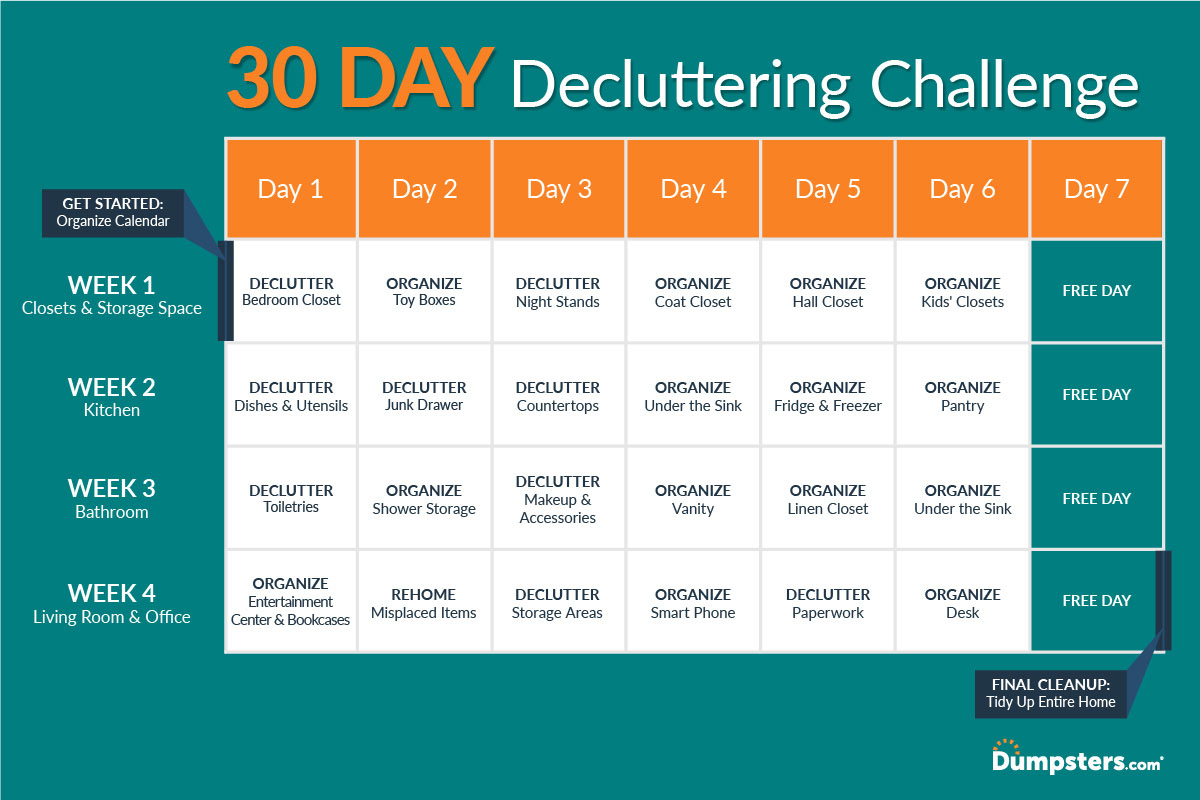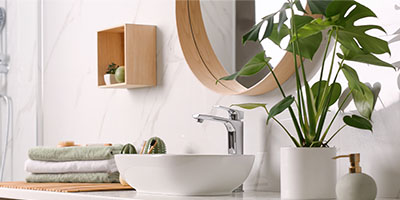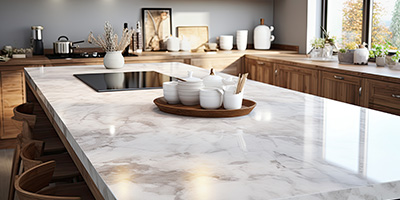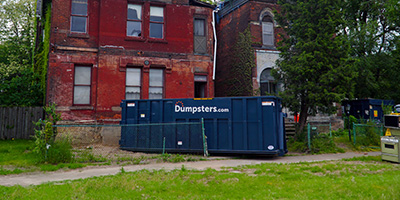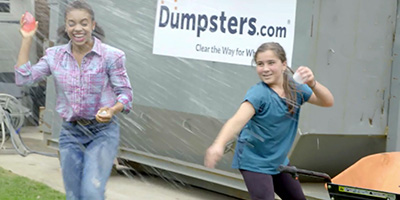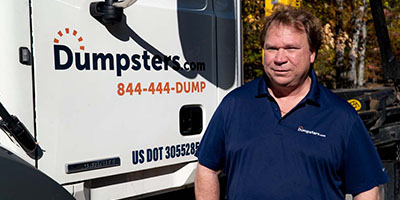Take the 30-Day Decluttering Challenge
Get your house in order from top to bottom with our easy organization hacks, plus tips from the experts.
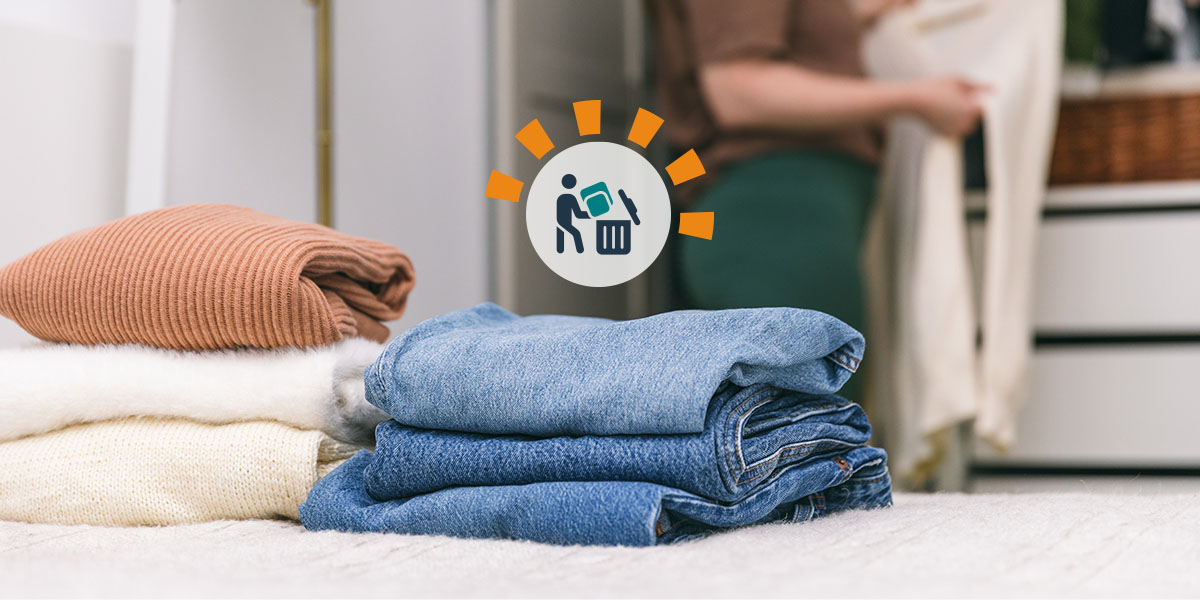
Get Your Home in Order With One Organizing Task per Day
Are you desperate to get your house organized but don’t know where to start? We teamed up with nine professional organizers to create a 30-day declutter challenge checklist to help you get your house in order and keep it clean. If you hit a week that requires getting rid of lots of junk, rent a dumpster to simplify the cleanup process.
We worked with Tonia Tomlin of Sorted Out, Barbara Reich of Life Organized, Julie Bestry from Best Results Organizing, Perri Kersh owner of Neat Freak Professional Organizing LLC, Ben Soreff of House to Home Organizing, Kathy Vines of Clever Girl Organizing, Kristen Ziegler of Minima, Amy Trager of AmyTrager.com, and Amy Vance of Eco Modern Concierge to help create a list of daily manageable tasks, and provide tips and tricks to manage your decluttering process more efficiently.
What Is the 30-Day Declutter Challenge?
This challenge is a month-long plan to help you remove excess clutter in your life. Each week addresses a room in your home and helps you tackle small tasks day by day to make a big impact through little tasks. Our decluttering challenge tackles the kitchen, bathroom, living room, office and storage spaces to keep you organized.
Declutter Your Home in a Month
We’ve broken up the home into four groups to help you tackle each area thoroughly within a month. Don’t worry — we’ve included a free day each week to give you a break or let you catch up on tasks. Bookmark this page, print the calendar and get to work. Good luck!
Get Started
Before we dive in, take a day to get yourself in the cleaning mindset. Start small by clearing out your day planner or digital calendar tasks and get yourself organized. You can even put all of the following tasks into your phone and set reminders to stay on track. Make sure you have everything you know you'll need to get started. Purchase organizing supplies like labels, organizers and storage bins to get the ball rolling.
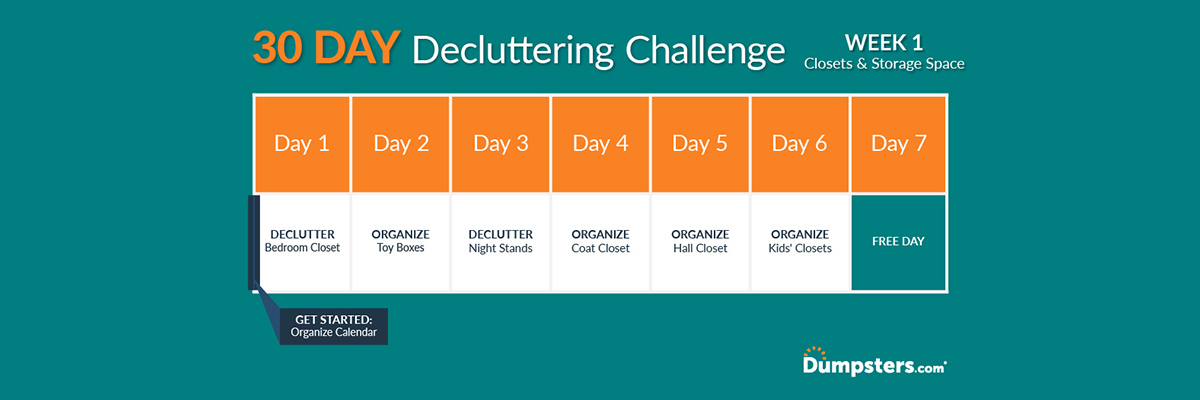
Week 1. Declutter, Organize Closets and Storage Spaces
Day 1. Declutter Your Bedroom Closet
Grab some trash bags and head to the bedroom. It’s time to purge your closet and get rid of the clothes you forgot you had.
How to Organize Your Bedroom Closet:
☐ Ask yourself: "Does it fit?" "Would I still wear it?" "Is it still in good condition?"
☐ Group your “keep” items into categories: sweaters, dress shirts, pants, etc.
☐ Use a second clothes rod, shoe rack, drawers or shelves to maximize storage space.
For more in-depth tips, check out our closet cleanout guide.

Pro Tip
Before you get started, take everything out of the closet. This will help you see the space you have to work with as you put your “keep” items back in.
Day 2. Control Toy Box Chaos
Getting a handle on toy box clutter will ensure you have a place for everything and make cleaning go smoother.
Tips for Toy Box Organization:
☐ Sort through toys without your kids, unless they can handle letting go of the things they’ve outgrown.
☐ Store frequently used toys on open shelves or in baskets where kids can easily reach them and put them back.
☐ Divide items between boxes so your kids can see all the toys available.
Day 3. Clear off Nightstands
It’s hard to relax around clutter. Get miscellaneous items off your nightstand and you’ll be poised for a restful night’s sleep.
Tomlin’s Tips for a Peaceful Bedside Table:
☐ Use stackable drawer organizers for the items stored in your bedside table.
☐ Install clear dividers so you can easily see everything you have.
☐ Label your drawer dividers so you know exactly where to put things back after use.

“I recommend storing a very small number of items in your nightstand. Chapstick, book, kindle or iPad, phone charger, ear buds, small tissue package — only what you truly need at your fingertips in the evening.”
Day 4. Organize the Coat Closet
Whether it’s part of a mudroom or tucked beside your front door, it’s easy for your coat closet to turn into a catch-all.
Try These Coat Closet Organization Ideas:
☐ Remove anything you don’t need when you’re entering or leaving your house. Re-home those items where you actually use them.
☐ Rethink how many coats each member of your household needs. Most of the time, one everyday coat and one for dressy occasions is plenty.
☐ Store out-of-season items in your basement or attic so you can quickly get to the outerwear you need for the current weather.
Day 5. Organize the Hall Closet
It’s easy for hall closets to turn into a giant junk drawer for your home. Cut through the clutter and find what’s valuable vs. what needs to go.
Tips for a Neater Hall Closet:
☐ Group your “keep” items by category.
☐ Toss or donate any items you haven’t pulled out of the closet in the last year.
☐ Use vertical space. Hang a shoe organizer on the back of the door to use as storage and set plastic drawers on shelves.
Day 6. Organize Children's Closets
It seems like a big job, but once you get your kids’ closets organized, you’ll have a much easier time getting them ready for school in the morning.
Child Closet Organization Ideas:
☐ Get rid of anything your kids have outgrown or no longer wear. Group the rest by season and category.
☐ If you want your children to dress themselves, hang clothing where it can be easily reached.
☐ If children share a closet, separate clothing using labeled closet rod dividers.

“Put the things worn most in the place that’s most accessible and easiest to reach.”
Day 7. Free Day!
Take a breather — you’ve earned it! If you fell behind on your tasks, take this time to sort through the belongings you didn’t get to yet so you’ll be ready to move on to the next area of the house.
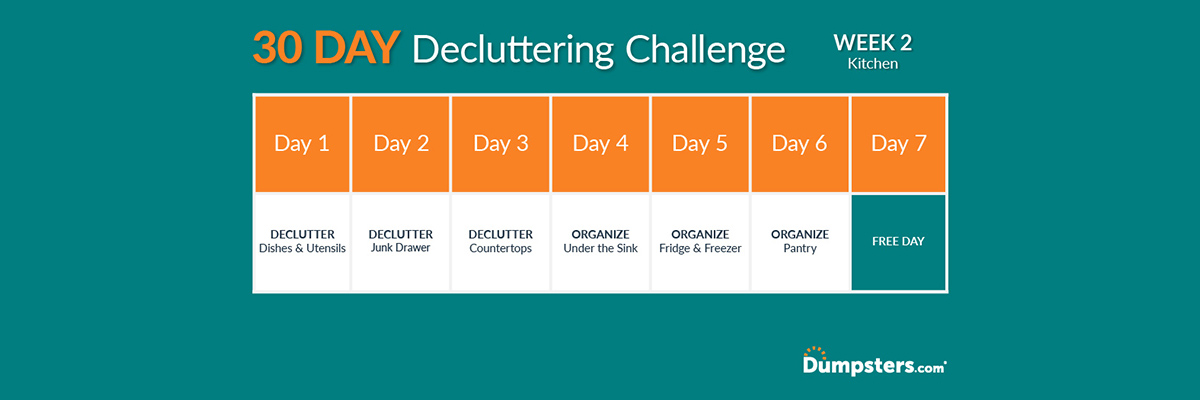
Week 2. Tidy up the Kitchen
Day 1. Sort Through Dishes & Utensils
Do you have three different sets of silverware and tons of mix-matched coffee mugs? Get a handle on kitchen clutter to get the heart of the home in order.
How to Clear out the Cabinets:
☐ Keep enough dishes for each family member to use between washings, plus a few more. Get rid of the extras and anything that’s broken or chipped.
☐ You cook nearly every day, so if you haven’t used a cooking utensil in the last month, it can probably go.
☐ Keep the utensils and dishes you only use during holidays and special occasions in bins at the back of your cupboards or on high shelves.
Day 2. Declutter the Kitchen Junk Drawer
It’s probably total chaos, but we found some helpful advice to make organizing your junk drawer a breeze.
Bestry’s Tips to Get the Junk Drawer Under Control:
☐ Empty the entire drawer onto the kitchen counter or table.
☐ Move anything edible, like sauce packets, to an appropriate place in the pantry.
☐ Toss anything broken or unnecessary, then group the remaining items into categories like tools, batteries, keys, office supplies, etc.

“It’s all about divide, contain and conquer. Get some inexpensive dollar store plastic baskets in multiple lengths and widths. You can arrange them as if you were playing a game of Tetris. Ice cube trays or mini muffin tins are great for containing very small items.”
Day 3. Clear off Countertops
Stop using your counter as a shelf and gain back the space you need to prepare meals. The trick is figuring out what belongs and what doesn’t.
Tips to Declutter Kitchen Countertops:
☐ Remove decorative items. Display these on a shelf, on top of cabinets or another out-of-the-way spot.
☐ Store away appliances you don’t use often. An exception might be a stand mixer, which is usually too big and heavy to keep anywhere else.
☐ Use vertical space. Get racks for spices, cooking oils and paper towels and mount them on the wall, or use a magnetic version on the side of the fridge.
Day 4. Tidy up Under the Sink
This is likely where you stuff cleaning supplies, which, ironically, can turn into a total mess. Use this list to make it easy to find what you need.
Simple Organizing Tricks:
☐ Use pull-out storage or a Lazy Susan to find what you need fast.
☐ Be honest about the products you actually use and get rid of the other supplies.
☐ Hang hooks or tension rods to create extra space for dish rags, gloves and other items.

Safety Tip
Remember to toss any expired cleaning products, which can be dangerous to use past their expiration date, and sponges older than a few weeks, which can harbor harmful bacteria.
Day 5. Organize the Fridge and Freezer
Tired of wasting money on food you forgot you had or buying so much it goes bad before you can eat it? Start by emptying both the fridge and freezer and giving them a thorough cleaning. Then, use these tips from Kersh to keep them organized.
How to Keep a Tidier Fridge:
☐ Label drawers so you can unpack groceries directly into the correct area of the fridge.
☐ Do you have more than one open container of the same condiment? Keep the freshest and throw out the rest.
☐ Use small, plastic containers and group like with like. Designate certain areas of the fridge for particular product types, like drawers for produce and the top shelf for leftovers.
Get the Freezer in Order:
☐ Skip a trip to the grocery store and eat what’s already in the freezer.
☐ Set up a regular schedule to go through your freezer and take inventory to avoid buying duplicates.
☐ Just because something won’t go bad in the freezer doesn’t mean you should keep it. If you know you’ll never thaw and cook it, toss it.

“Plastic works best for organizing food because it’s easy to toss in the dishwasher or wipe clean if anything spills.”
Day 6. Get Your Pantry in Order
It’s easy for the pantry to turn into a mess of canned goods and boxed snacks. Use today’s task to get yours back into order with more advice from Kersh.
Guidance for an Organized Pantry:
☐ Place like items in containers, especially if your pantry has deep shelves.
☐ Use organizers that create height to store items that won’t fit in containers.
☐ Label containers or use clear plastic so it’s easy to find what you need. This also makes it easier to quickly and neatly unpack after a trip to the store.

“Containers act like drawers, allowing you to pull out the whole thing to find what you need rather than reaching into deep shelves to see what is in the back.”
Day 7. Free Day!
You’re on a roll! Time to relax — unless you missed a task or two. Then it’s time to catch up.
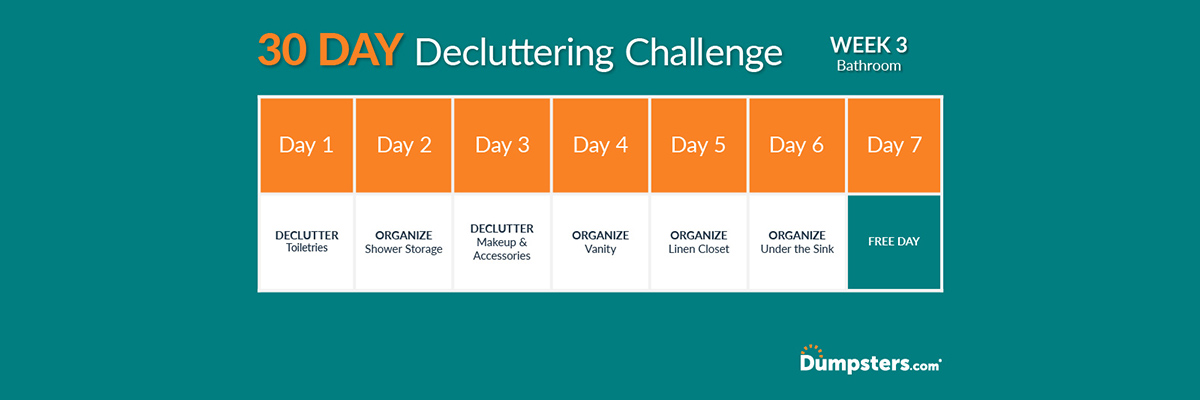
Week 3. Contain Bathroom Clutter
Day 1. Declutter Toiletries
Make your morning routine less stressful and get your bathroom organized by getting rid of the beauty and hygiene products you don’t use.
Tips for Organizing Personal Care Products:
☐ Do you have multiples of an item? Keep the brand you like best and toss or donate the others.
☐ Don’t feel obligated to hold onto gifts. If you’ll never use the bubble bath you got, donate or re-gift to someone who will.
☐ Get rid of aspirational products. Doing a daily face mask is a nice idea, but if you don’t have that kind of time, you’re better off letting it go.
Day 2. Organize Shower Storage
Now that you’ve figured out which toiletries to keep, it’s time to get them in order.
Create a Tidy Shower:
☐ Don’t forget to regularly run your loofahs through the wash.
☐ Wipe down or replace your shower caddies so they’re fresh and clean.
☐ Group products by category. Hair products on one shelf, face and body wash on another, etc.
Day 3. Organize Makeup and Accessories
Let’s be honest — beauty products are rarely beautifully organized. Use today’s task to tackle the clutter.
How to Declutter Your Makeup Bag:
☐ Toss anything that’s more than a year old. Makeup expires and can harbor bacteria after that point.
☐ Chuck all the free samples if you’re not using them. Even though they’re little, they’re just taking up space.
☐ Let go of products you don’t like. Don’t let an eyeshadow palette that doesn’t suit you take up space at the bottom of your bag.

“Don’t punish yourself for buying something you ended up not liking; chalk it up to a failed experiment. This has everything to do with quantity. Once you know what you are keeping, you can find the best storage solution.”
Day 4. Tidy the Vanity
An orderly vanity will help you get ready quicker, which means you’ll have more time to yourself in the morning.
Soreff’s Advice for an Organized Vanity:
☐ Group items into categories like dental, shaving, etc. Use drawer dividers to keep them contained.
☐ Don’t overbuy. If you can’t fit five toothpaste tubes within your dividers, pass up on the bulk pack no matter how good the deal is.
☐ Only keep the things you use frequently in or on your vanity. If you have products for special occasions, move them to the linen closet.
Day 5. Straighten up the Linen Closet
If you’re tired of shoving towels into an overstuffed closet or hoping the whole pile doesn’t come tumbling down when you take a pillowcase out, today’s task will help you get organized.
How to Achieve Orderly Linen Storage:
☐ Get rid of anything torn, worn or stained.
☐ Keep enough towels for each family member between washes, plus a few extra. Donate the rest.
☐ Unless you frequently have multiple overnight guests, only keep one extra set of bedding per bed.
Day 6. Declutter Under the Sink
Under the bathroom sink is the perfect recipe for out of sight, out of mind. If you use this space to stash miscellaneous items, it’s time to sort through.
How to Take Back the Space:
☐ Take everything out and immediately toss anything over a year old, broken or that shouldn’t be there.
☐ Put cleaning supplies in a shower caddy so they’re easy to grab when you need them and can be neatly put away when you’re done.
☐ Invest in stacking bins and group like items together, toiletries, cosmetics, first aid materials, etc. Use a cabinet door organizer to hold hair appliances.

“Under the sink often holds a mix of unused and forgotten bathroom cleaning supplies, toiletries, cosmetics and other health and beauty aids (old curlers set anyone?). Here’s a hint: if it’s dusty and grimy, it means it’s not being used. It’s time to get rid of the junk and liberate your space.”
Day 7. Free Day!
Rest day! If you have a guest bathroom you didn’t get to, this is the perfect day to rinse and repeat all the tasks you went through this week.
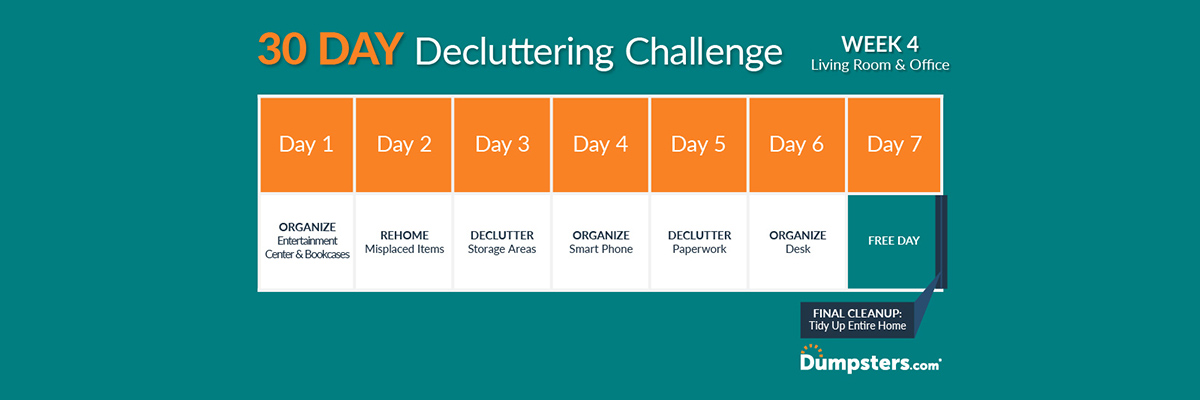
Week 4. Organize the Living Room and Office
If you need help minimizing the clutter in your living room, start by getting rid of the things that don’t carry sentimental value or provide a necessary function. Then, decide what to do with the rest.
Tips on Organizing the Important Things:
☐ Label each cord and use cable ties to group wires connected to the same device.
☐ Use baskets or decorative bins to hold remotes, video game controllers and other small accessories.
☐ Sort sentimental items into categories and only keep those that spark a strong, positive memory or feeling.

“I often help clients redesign their spaces, but only after we have decluttered. I find that when we remove what’s no longer loved or needed, the space tells us what it wants to be.”
Day 2. Rehome Misplaced Items
It’s easy for misplaced items to end up in the living room and clutter the floor and coffee table. Use today’s task to put them back where they belong.
How to Put Things Back Efficiently:
☐ File paperwork away in the office.
☐ Take toys back to your kids’ rooms or playroom.
☐ Return dishes to the kitchen and coats to their closet.
Day 3. Declutter Storage Areas
It’s time to bring order to the small spaces like end tables and ottomans that do a good job of hiding clutter.
Tips for Organizing Living Room Storage:
☐ Toss old electronics like cords and remotes that you no longer need.
☐ Get rid of throw blankets and pillows that are worn out or simply not needed.
☐ Treat these spaces like other storage areas and use dividers or plastic containers to organize small items.
Day 4. Organize Your Smartphone
It can be distracting and difficult to conduct business on your phone or get to the app you need when you have pages of apps and hundreds of notifications. It’s time to get a hold on your phone.
Get Your Phone in Order:
☐ Delete old apps and get rid of any that are similar.
☐ Create albums to archive photos and delete duplicates and blurry pictures.
☐ Listen to old messages and delete the voicemails you don’t need.
Day 5. Declutter Paperwork Piles
It’s a tedious task, but you’ll thank yourself when you need to quickly find an important document. Vance us some advice on the best ways to organize paperwork.
Vance’s Tips for Getting Papers in Order:
☐ Clean paper off surfaces like your desk, counters and kitchen table every night.
☐ Go paperless wherever possible and remove yourself from mailing lists so you’ll have less junk mail to sort through each day.
☐ Deal with mail as soon as it comes in. Have a recycle bin and shredder nearby for junk, then schedule a time to go through the keepers every evening.
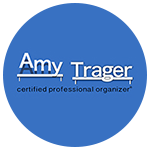
“When it comes to organizing paperwork, one of the biggest problems is that paper stacks up everywhere. Prevent this by giving your paper piles a physical limitation. Use a mail sorter or magazine holder to vertically corral mail and papers as they enter the home or office. Once this holder is full, you’ll have no choice but to tackle the paperwork.”
Day 6. Organize Your Desk
It’s time to tackle your desktop and drawers to create a home office that helps you stay focused.
Vance’s Advice for an Orderly Desk:
☐ Use a desktop file system with folders or bins for categories like, “To Be Paid,” “Paid,” “File,” “Outgoing Mail” and “To Read.”
☐ Keep items you will need to access often, like staplers, stamps, checkbooks and envelopes, near the top drawers of your desk.
☐ Utilize pen holders for pens, scissors, highlighters, etc. Group items by category and be realistic about how many of each you need.
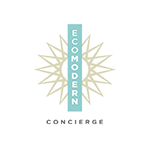
“Make a list of file categories that work for you based on your paperwork. But try to keep it to six files or less if possible, so it doesn’t get overwhelming.”
Day 7. Free Day!
You made it through arguably one of the hardest rooms to clean, the catch-all we like to mask as a home office. Reward yourself by kicking your feet up or doing something fun.

Take a Final Walk-Through
Now that you finally have the whole house in order, it’s time to do a last sweep through every room. If you’ve organized the right way, there shouldn’t be too much clutter and it should be easy to put things back.
Live a Clutter-Free Life
Congratulations! You decluttered your house in 30 days. Whether you checked off every task on the list or just focused on your problem areas, we hope our decluttering challenge helped you get organized. Now it’s time to pick up your feet in your freshly organized living room, relax and enjoy the results of your hard work.
Want to make sure your house stays clean? Check out our tips for keeping a clutter-free home.
Expert Contributors

Tonia Tomlin
Tonia of Sorted Out Organizing Service in Plano, TX assesses your specific situation, goals and needs to tailor immediate and long-lasting solutions. She gives you expert, nonjudgmental guidance and tips. Using her innovative proprietary systems, she provides caring, comprehensive service ― from initial consultation to organizational maintenance to backsliding prevention ― so you get the best, most effective structures for you.

Barbara Reich
Based in Manhattan, professional organizer Barbara has over 20 years of experience in organizing people's lives and spaces. She has been featured in the New York Times, the Wall Street Journal, the Washington Post, the New York Post and countless other publications. Her book, Secrets of an Organized Mom, is the 2014 winner of the Mom's Choice Award.

Julie Bestry
President of Best Results Organizing, Julie is a Certified Professional Organizer sharing her experience in Chattanooga, TN. She helps residential, home office and corporate clients save time and increase productivity. In addition to working with clients one-on-one, she frequently shares her expertise in organizing and time management with companies, professional organizations and volunteer groups. Julie also shares her insight and advice on subjects related to having a more organized life with local media.

Perri Kersh
Organizing expert Perri provides simple and personalized solutions for her clients in Chapel Hill, NC. A member of NAPO, Perri enjoys teaching fundamental organizing and productivity skills, as well as coaching new organizers. She works with a variety of clients and is a frequent contributor to local national and local publications including Fine Living and South Africa's Home Channel.

Ben Soreff
Over the last 14 years, Ben has worked on countless organizing projects in Fairfield County. After a successful career in television, Ben created House to Home Organizing to help his clients gain a better quality of life. He now works with a range of clients from busy stay-at-home parents to hoarding situations in need. He helps create an organized environment by not taking the process too seriously and bringing joy into the decluttering process.

Kathy Vines
Working in the Greater Boston area, Kathy is a Certified Professional Organizer, business owner and speaker. She collaborates with clients to bring serenity and order into a home and focuses on what is getting in the way of clients so they can live an organized life. Before working in organizing, Kathy had a 20-year career in Human Resources and uses her background to create solutions for her individual clients.

Kristen Ziegler
Kristen is an organizing expert and owner of Minima. Based in Richmond, VA, Minima offers professional organizing and redesign services. Since 2010, the company has developed a clear process to ensure lasting results for its clients.

Amy Trager
Certified Professional Organizer and member of NAPO, Amy has been working in the Chicago area since 2006. She has a custom degree from Bradley University that allowed her to study in the organizing industry. She has worked in Housing and Interior Design Concepts, Family Systems and Applications, and has presented "The Study of/Research and Analysis of Professional Organizing" at Bradley's Annual Research Expo, resulting in publication in a professional journal.

Amy Vance
Amy has been helping people get organized in the Houston area for over 15 years. As the owner of Eco Modern Concierge, Amy assists clients in achieving a work and life balance to alleviate stress. Overall, her work strives to help others tackle their personal and professional organizing needs in a sustainable, prompt and mindful way.
What Do You Think?
Just finished organizing your home? Share some tips with us. Head over to Twitter or Facebook,
and use #dumpstersblog to join the conversation.



